NUR2300 Case Study Assessment: Evidence-Based Practice in Healthcare
VerifiedAdded on 2022/08/19
|12
|2517
|13
Case Study
AI Summary
This case study assessment for a nursing course focuses on evidence-based practice (EBP) in healthcare, specifically addressing acute abdominal pain management. The assessment begins with answering questions related to EBP, followed by a critical appraisal of a systematic review. The review evaluates the impact of pain relief on diagnostic accuracy. The study also examines organizational, individual, and interdisciplinary barriers to implementing EBP, alongside strategies for improvement. The assessment concludes with a discussion on techniques for evaluating the fruitfulness of EBP, including electronic and manual audits and feedback mechanisms. Finally, the study suggests skill development sessions, staff training, and peer support as crucial elements for successful implementation of evidence-based practice in nursing.
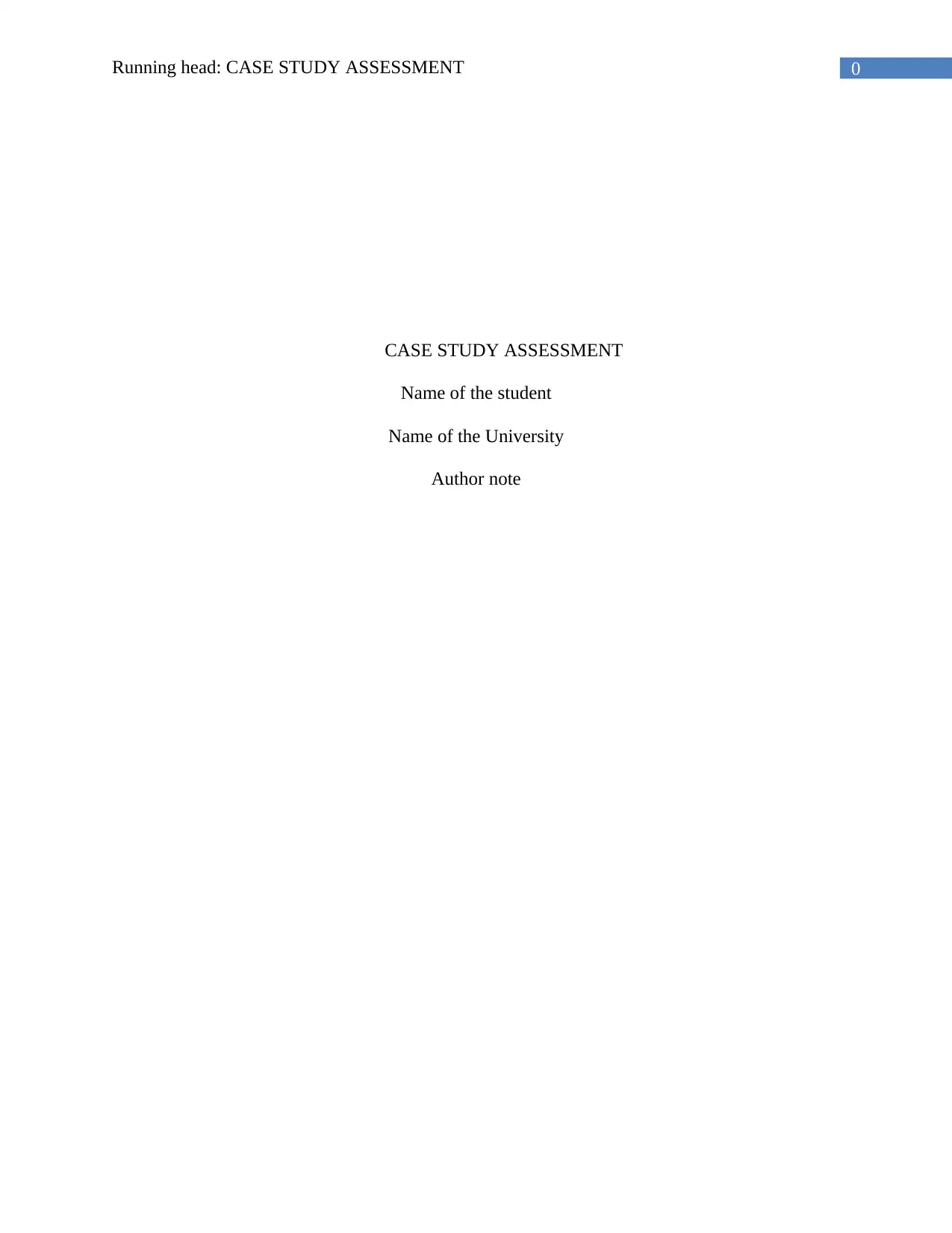
0Running head: CASE STUDY ASSESSMENT
CASE STUDY ASSESSMENT
Name of the student
Name of the University
Author note
CASE STUDY ASSESSMENT
Name of the student
Name of the University
Author note
Paraphrase This Document
Need a fresh take? Get an instant paraphrase of this document with our AI Paraphraser
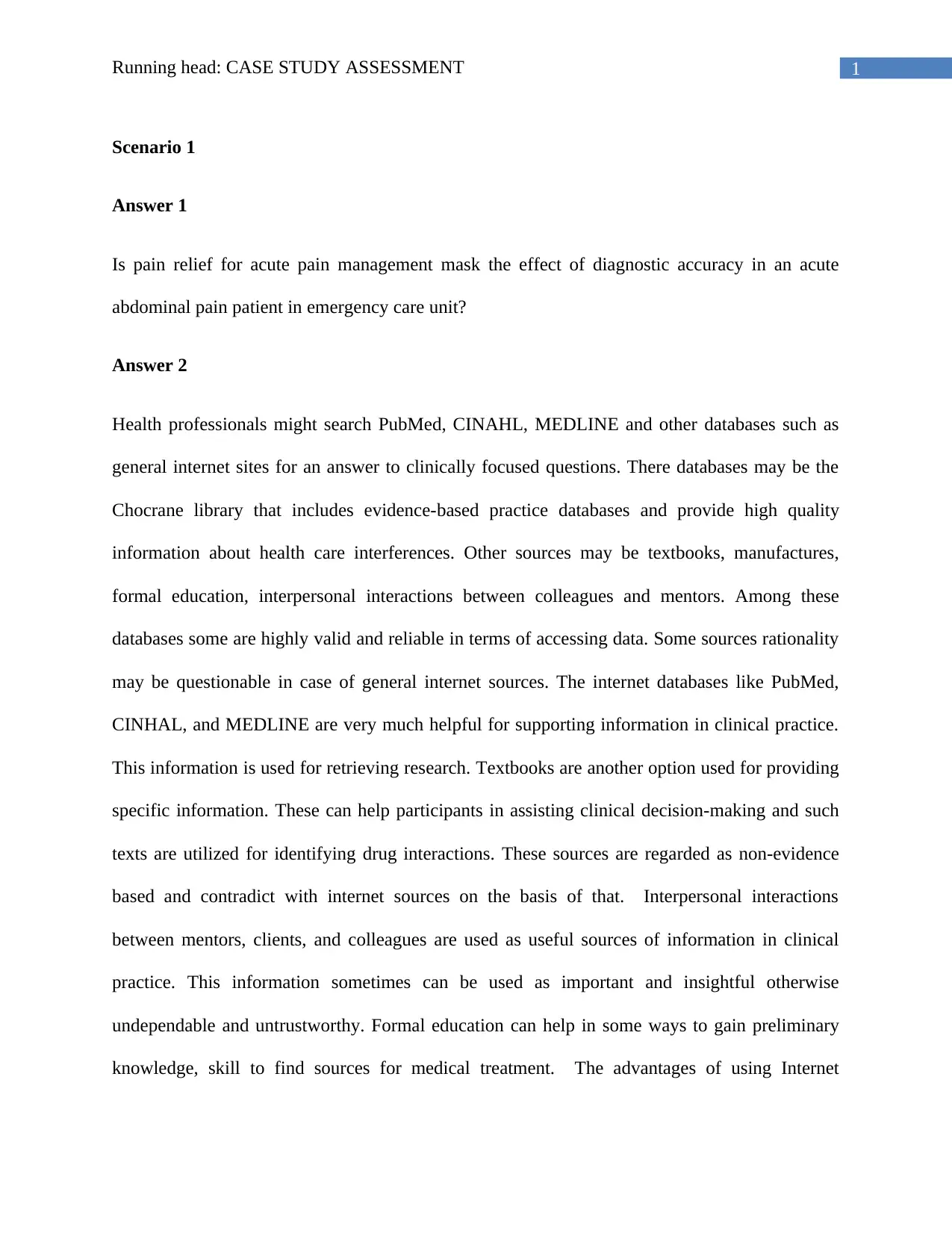
1Running head: CASE STUDY ASSESSMENT
Scenario 1
Answer 1
Is pain relief for acute pain management mask the effect of diagnostic accuracy in an acute
abdominal pain patient in emergency care unit?
Answer 2
Health professionals might search PubMed, CINAHL, MEDLINE and other databases such as
general internet sites for an answer to clinically focused questions. There databases may be the
Chocrane library that includes evidence-based practice databases and provide high quality
information about health care interferences. Other sources may be textbooks, manufactures,
formal education, interpersonal interactions between colleagues and mentors. Among these
databases some are highly valid and reliable in terms of accessing data. Some sources rationality
may be questionable in case of general internet sources. The internet databases like PubMed,
CINHAL, and MEDLINE are very much helpful for supporting information in clinical practice.
This information is used for retrieving research. Textbooks are another option used for providing
specific information. These can help participants in assisting clinical decision-making and such
texts are utilized for identifying drug interactions. These sources are regarded as non-evidence
based and contradict with internet sources on the basis of that. Interpersonal interactions
between mentors, clients, and colleagues are used as useful sources of information in clinical
practice. This information sometimes can be used as important and insightful otherwise
undependable and untrustworthy. Formal education can help in some ways to gain preliminary
knowledge, skill to find sources for medical treatment. The advantages of using Internet
Scenario 1
Answer 1
Is pain relief for acute pain management mask the effect of diagnostic accuracy in an acute
abdominal pain patient in emergency care unit?
Answer 2
Health professionals might search PubMed, CINAHL, MEDLINE and other databases such as
general internet sites for an answer to clinically focused questions. There databases may be the
Chocrane library that includes evidence-based practice databases and provide high quality
information about health care interferences. Other sources may be textbooks, manufactures,
formal education, interpersonal interactions between colleagues and mentors. Among these
databases some are highly valid and reliable in terms of accessing data. Some sources rationality
may be questionable in case of general internet sources. The internet databases like PubMed,
CINHAL, and MEDLINE are very much helpful for supporting information in clinical practice.
This information is used for retrieving research. Textbooks are another option used for providing
specific information. These can help participants in assisting clinical decision-making and such
texts are utilized for identifying drug interactions. These sources are regarded as non-evidence
based and contradict with internet sources on the basis of that. Interpersonal interactions
between mentors, clients, and colleagues are used as useful sources of information in clinical
practice. This information sometimes can be used as important and insightful otherwise
undependable and untrustworthy. Formal education can help in some ways to gain preliminary
knowledge, skill to find sources for medical treatment. The advantages of using Internet
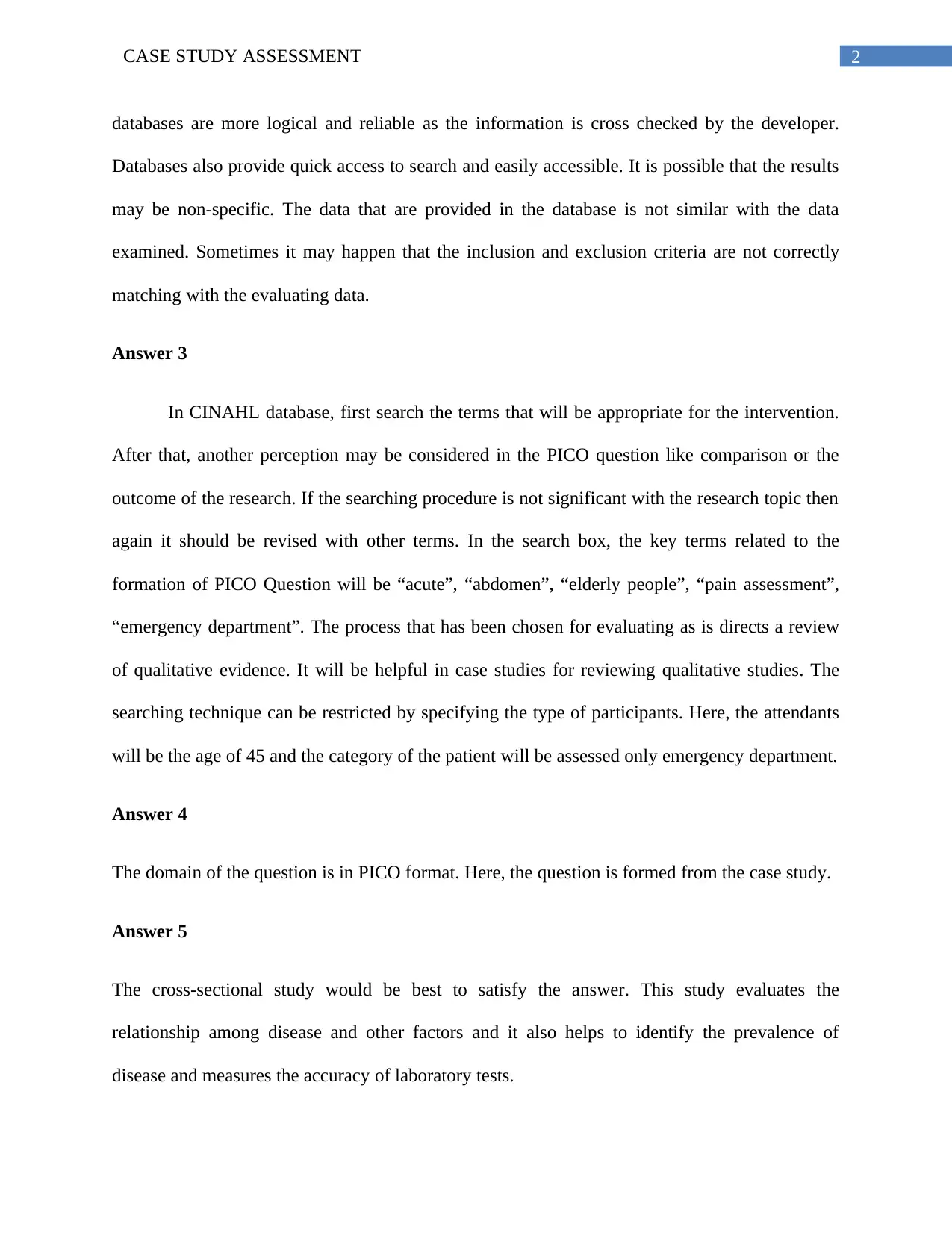
2CASE STUDY ASSESSMENT
databases are more logical and reliable as the information is cross checked by the developer.
Databases also provide quick access to search and easily accessible. It is possible that the results
may be non-specific. The data that are provided in the database is not similar with the data
examined. Sometimes it may happen that the inclusion and exclusion criteria are not correctly
matching with the evaluating data.
Answer 3
In CINAHL database, first search the terms that will be appropriate for the intervention.
After that, another perception may be considered in the PICO question like comparison or the
outcome of the research. If the searching procedure is not significant with the research topic then
again it should be revised with other terms. In the search box, the key terms related to the
formation of PICO Question will be “acute”, “abdomen”, “elderly people”, “pain assessment”,
“emergency department”. The process that has been chosen for evaluating as is directs a review
of qualitative evidence. It will be helpful in case studies for reviewing qualitative studies. The
searching technique can be restricted by specifying the type of participants. Here, the attendants
will be the age of 45 and the category of the patient will be assessed only emergency department.
Answer 4
The domain of the question is in PICO format. Here, the question is formed from the case study.
Answer 5
The cross-sectional study would be best to satisfy the answer. This study evaluates the
relationship among disease and other factors and it also helps to identify the prevalence of
disease and measures the accuracy of laboratory tests.
databases are more logical and reliable as the information is cross checked by the developer.
Databases also provide quick access to search and easily accessible. It is possible that the results
may be non-specific. The data that are provided in the database is not similar with the data
examined. Sometimes it may happen that the inclusion and exclusion criteria are not correctly
matching with the evaluating data.
Answer 3
In CINAHL database, first search the terms that will be appropriate for the intervention.
After that, another perception may be considered in the PICO question like comparison or the
outcome of the research. If the searching procedure is not significant with the research topic then
again it should be revised with other terms. In the search box, the key terms related to the
formation of PICO Question will be “acute”, “abdomen”, “elderly people”, “pain assessment”,
“emergency department”. The process that has been chosen for evaluating as is directs a review
of qualitative evidence. It will be helpful in case studies for reviewing qualitative studies. The
searching technique can be restricted by specifying the type of participants. Here, the attendants
will be the age of 45 and the category of the patient will be assessed only emergency department.
Answer 4
The domain of the question is in PICO format. Here, the question is formed from the case study.
Answer 5
The cross-sectional study would be best to satisfy the answer. This study evaluates the
relationship among disease and other factors and it also helps to identify the prevalence of
disease and measures the accuracy of laboratory tests.
⊘ This is a preview!⊘
Do you want full access?
Subscribe today to unlock all pages.

Trusted by 1+ million students worldwide
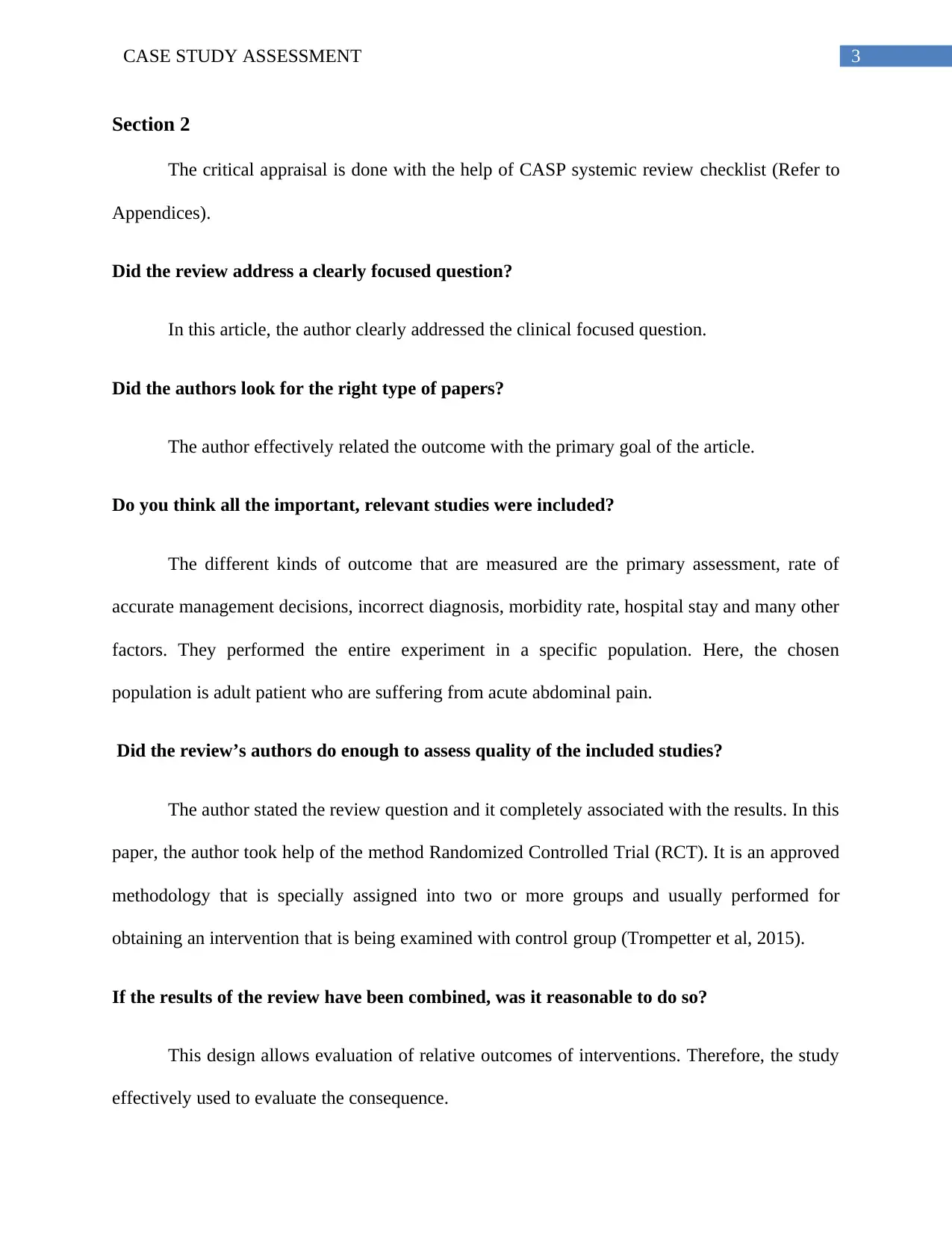
3CASE STUDY ASSESSMENT
Section 2
The critical appraisal is done with the help of CASP systemic review checklist (Refer to
Appendices).
Did the review address a clearly focused question?
In this article, the author clearly addressed the clinical focused question.
Did the authors look for the right type of papers?
The author effectively related the outcome with the primary goal of the article.
Do you think all the important, relevant studies were included?
The different kinds of outcome that are measured are the primary assessment, rate of
accurate management decisions, incorrect diagnosis, morbidity rate, hospital stay and many other
factors. They performed the entire experiment in a specific population. Here, the chosen
population is adult patient who are suffering from acute abdominal pain.
Did the review’s authors do enough to assess quality of the included studies?
The author stated the review question and it completely associated with the results. In this
paper, the author took help of the method Randomized Controlled Trial (RCT). It is an approved
methodology that is specially assigned into two or more groups and usually performed for
obtaining an intervention that is being examined with control group (Trompetter et al, 2015).
If the results of the review have been combined, was it reasonable to do so?
This design allows evaluation of relative outcomes of interventions. Therefore, the study
effectively used to evaluate the consequence.
Section 2
The critical appraisal is done with the help of CASP systemic review checklist (Refer to
Appendices).
Did the review address a clearly focused question?
In this article, the author clearly addressed the clinical focused question.
Did the authors look for the right type of papers?
The author effectively related the outcome with the primary goal of the article.
Do you think all the important, relevant studies were included?
The different kinds of outcome that are measured are the primary assessment, rate of
accurate management decisions, incorrect diagnosis, morbidity rate, hospital stay and many other
factors. They performed the entire experiment in a specific population. Here, the chosen
population is adult patient who are suffering from acute abdominal pain.
Did the review’s authors do enough to assess quality of the included studies?
The author stated the review question and it completely associated with the results. In this
paper, the author took help of the method Randomized Controlled Trial (RCT). It is an approved
methodology that is specially assigned into two or more groups and usually performed for
obtaining an intervention that is being examined with control group (Trompetter et al, 2015).
If the results of the review have been combined, was it reasonable to do so?
This design allows evaluation of relative outcomes of interventions. Therefore, the study
effectively used to evaluate the consequence.
Paraphrase This Document
Need a fresh take? Get an instant paraphrase of this document with our AI Paraphraser
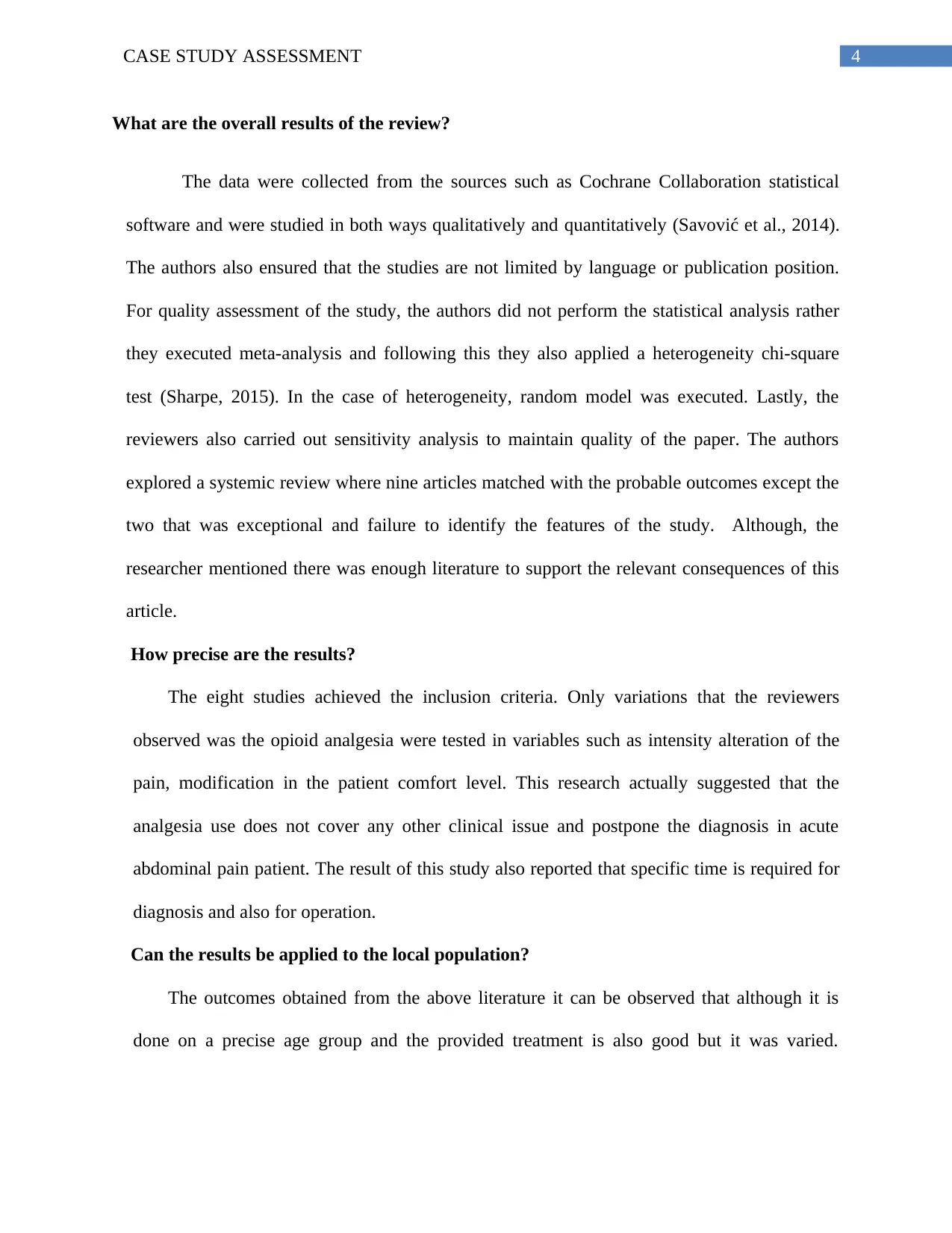
4CASE STUDY ASSESSMENT
What are the overall results of the review?
The data were collected from the sources such as Cochrane Collaboration statistical
software and were studied in both ways qualitatively and quantitatively (Savović et al., 2014).
The authors also ensured that the studies are not limited by language or publication position.
For quality assessment of the study, the authors did not perform the statistical analysis rather
they executed meta-analysis and following this they also applied a heterogeneity chi-square
test (Sharpe, 2015). In the case of heterogeneity, random model was executed. Lastly, the
reviewers also carried out sensitivity analysis to maintain quality of the paper. The authors
explored a systemic review where nine articles matched with the probable outcomes except the
two that was exceptional and failure to identify the features of the study. Although, the
researcher mentioned there was enough literature to support the relevant consequences of this
article.
How precise are the results?
The eight studies achieved the inclusion criteria. Only variations that the reviewers
observed was the opioid analgesia were tested in variables such as intensity alteration of the
pain, modification in the patient comfort level. This research actually suggested that the
analgesia use does not cover any other clinical issue and postpone the diagnosis in acute
abdominal pain patient. The result of this study also reported that specific time is required for
diagnosis and also for operation.
Can the results be applied to the local population?
The outcomes obtained from the above literature it can be observed that although it is
done on a precise age group and the provided treatment is also good but it was varied.
What are the overall results of the review?
The data were collected from the sources such as Cochrane Collaboration statistical
software and were studied in both ways qualitatively and quantitatively (Savović et al., 2014).
The authors also ensured that the studies are not limited by language or publication position.
For quality assessment of the study, the authors did not perform the statistical analysis rather
they executed meta-analysis and following this they also applied a heterogeneity chi-square
test (Sharpe, 2015). In the case of heterogeneity, random model was executed. Lastly, the
reviewers also carried out sensitivity analysis to maintain quality of the paper. The authors
explored a systemic review where nine articles matched with the probable outcomes except the
two that was exceptional and failure to identify the features of the study. Although, the
researcher mentioned there was enough literature to support the relevant consequences of this
article.
How precise are the results?
The eight studies achieved the inclusion criteria. Only variations that the reviewers
observed was the opioid analgesia were tested in variables such as intensity alteration of the
pain, modification in the patient comfort level. This research actually suggested that the
analgesia use does not cover any other clinical issue and postpone the diagnosis in acute
abdominal pain patient. The result of this study also reported that specific time is required for
diagnosis and also for operation.
Can the results be applied to the local population?
The outcomes obtained from the above literature it can be observed that although it is
done on a precise age group and the provided treatment is also good but it was varied.
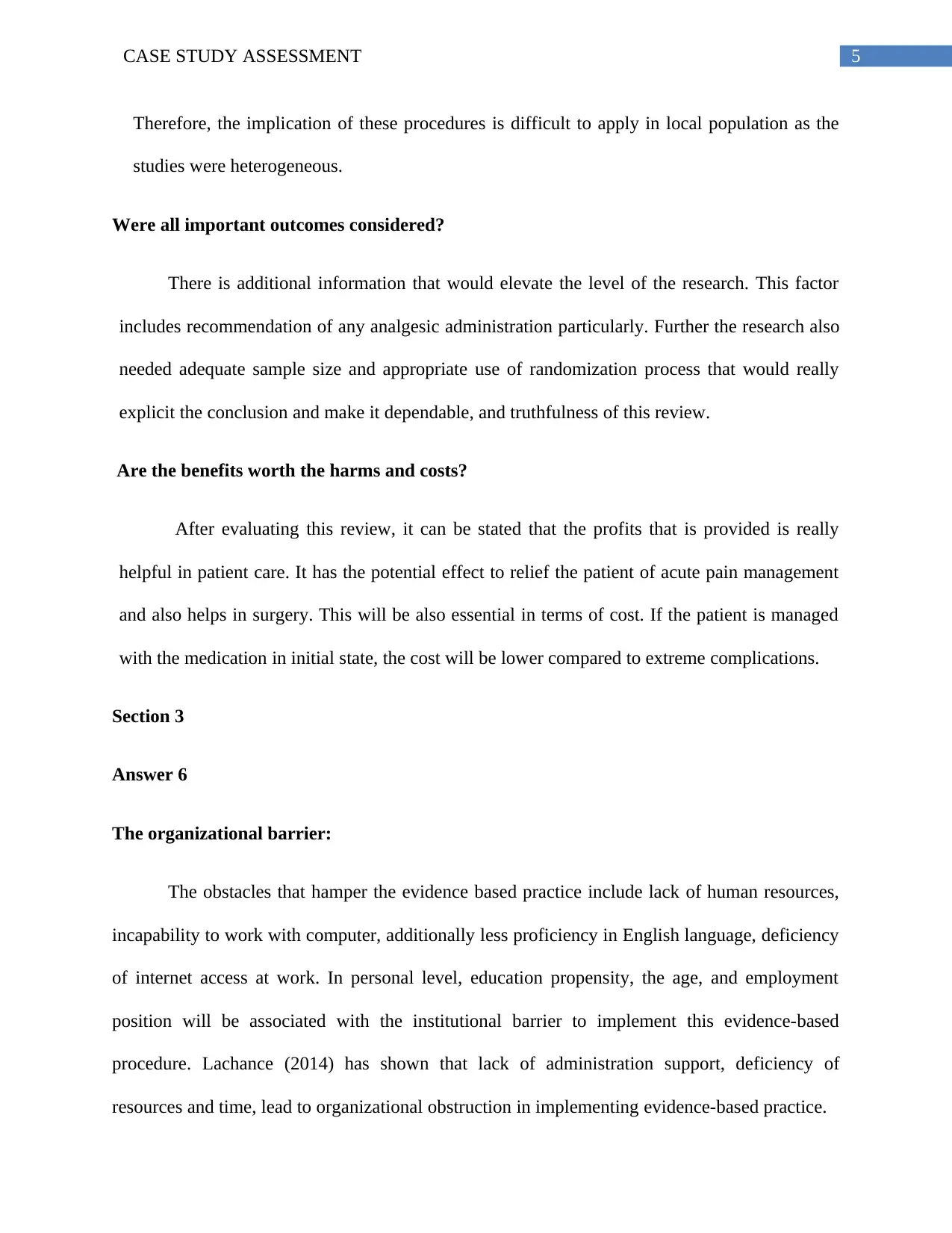
5CASE STUDY ASSESSMENT
Therefore, the implication of these procedures is difficult to apply in local population as the
studies were heterogeneous.
Were all important outcomes considered?
There is additional information that would elevate the level of the research. This factor
includes recommendation of any analgesic administration particularly. Further the research also
needed adequate sample size and appropriate use of randomization process that would really
explicit the conclusion and make it dependable, and truthfulness of this review.
Are the benefits worth the harms and costs?
After evaluating this review, it can be stated that the profits that is provided is really
helpful in patient care. It has the potential effect to relief the patient of acute pain management
and also helps in surgery. This will be also essential in terms of cost. If the patient is managed
with the medication in initial state, the cost will be lower compared to extreme complications.
Section 3
Answer 6
The organizational barrier:
The obstacles that hamper the evidence based practice include lack of human resources,
incapability to work with computer, additionally less proficiency in English language, deficiency
of internet access at work. In personal level, education propensity, the age, and employment
position will be associated with the institutional barrier to implement this evidence-based
procedure. Lachance (2014) has shown that lack of administration support, deficiency of
resources and time, lead to organizational obstruction in implementing evidence-based practice.
Therefore, the implication of these procedures is difficult to apply in local population as the
studies were heterogeneous.
Were all important outcomes considered?
There is additional information that would elevate the level of the research. This factor
includes recommendation of any analgesic administration particularly. Further the research also
needed adequate sample size and appropriate use of randomization process that would really
explicit the conclusion and make it dependable, and truthfulness of this review.
Are the benefits worth the harms and costs?
After evaluating this review, it can be stated that the profits that is provided is really
helpful in patient care. It has the potential effect to relief the patient of acute pain management
and also helps in surgery. This will be also essential in terms of cost. If the patient is managed
with the medication in initial state, the cost will be lower compared to extreme complications.
Section 3
Answer 6
The organizational barrier:
The obstacles that hamper the evidence based practice include lack of human resources,
incapability to work with computer, additionally less proficiency in English language, deficiency
of internet access at work. In personal level, education propensity, the age, and employment
position will be associated with the institutional barrier to implement this evidence-based
procedure. Lachance (2014) has shown that lack of administration support, deficiency of
resources and time, lead to organizational obstruction in implementing evidence-based practice.
⊘ This is a preview!⊘
Do you want full access?
Subscribe today to unlock all pages.

Trusted by 1+ million students worldwide
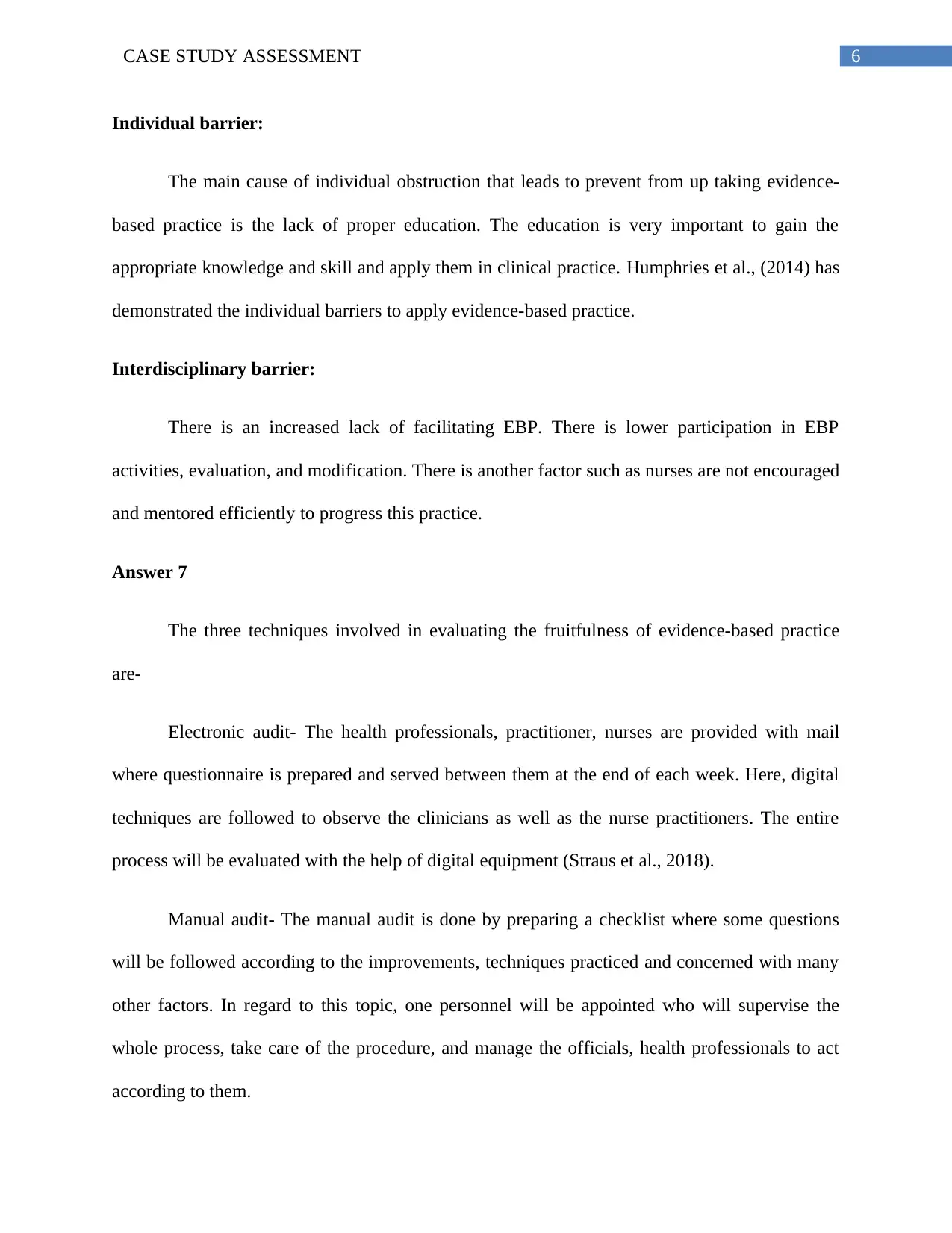
6CASE STUDY ASSESSMENT
Individual barrier:
The main cause of individual obstruction that leads to prevent from up taking evidence-
based practice is the lack of proper education. The education is very important to gain the
appropriate knowledge and skill and apply them in clinical practice. Humphries et al., (2014) has
demonstrated the individual barriers to apply evidence-based practice.
Interdisciplinary barrier:
There is an increased lack of facilitating EBP. There is lower participation in EBP
activities, evaluation, and modification. There is another factor such as nurses are not encouraged
and mentored efficiently to progress this practice.
Answer 7
The three techniques involved in evaluating the fruitfulness of evidence-based practice
are-
Electronic audit- The health professionals, practitioner, nurses are provided with mail
where questionnaire is prepared and served between them at the end of each week. Here, digital
techniques are followed to observe the clinicians as well as the nurse practitioners. The entire
process will be evaluated with the help of digital equipment (Straus et al., 2018).
Manual audit- The manual audit is done by preparing a checklist where some questions
will be followed according to the improvements, techniques practiced and concerned with many
other factors. In regard to this topic, one personnel will be appointed who will supervise the
whole process, take care of the procedure, and manage the officials, health professionals to act
according to them.
Individual barrier:
The main cause of individual obstruction that leads to prevent from up taking evidence-
based practice is the lack of proper education. The education is very important to gain the
appropriate knowledge and skill and apply them in clinical practice. Humphries et al., (2014) has
demonstrated the individual barriers to apply evidence-based practice.
Interdisciplinary barrier:
There is an increased lack of facilitating EBP. There is lower participation in EBP
activities, evaluation, and modification. There is another factor such as nurses are not encouraged
and mentored efficiently to progress this practice.
Answer 7
The three techniques involved in evaluating the fruitfulness of evidence-based practice
are-
Electronic audit- The health professionals, practitioner, nurses are provided with mail
where questionnaire is prepared and served between them at the end of each week. Here, digital
techniques are followed to observe the clinicians as well as the nurse practitioners. The entire
process will be evaluated with the help of digital equipment (Straus et al., 2018).
Manual audit- The manual audit is done by preparing a checklist where some questions
will be followed according to the improvements, techniques practiced and concerned with many
other factors. In regard to this topic, one personnel will be appointed who will supervise the
whole process, take care of the procedure, and manage the officials, health professionals to act
according to them.
Paraphrase This Document
Need a fresh take? Get an instant paraphrase of this document with our AI Paraphraser
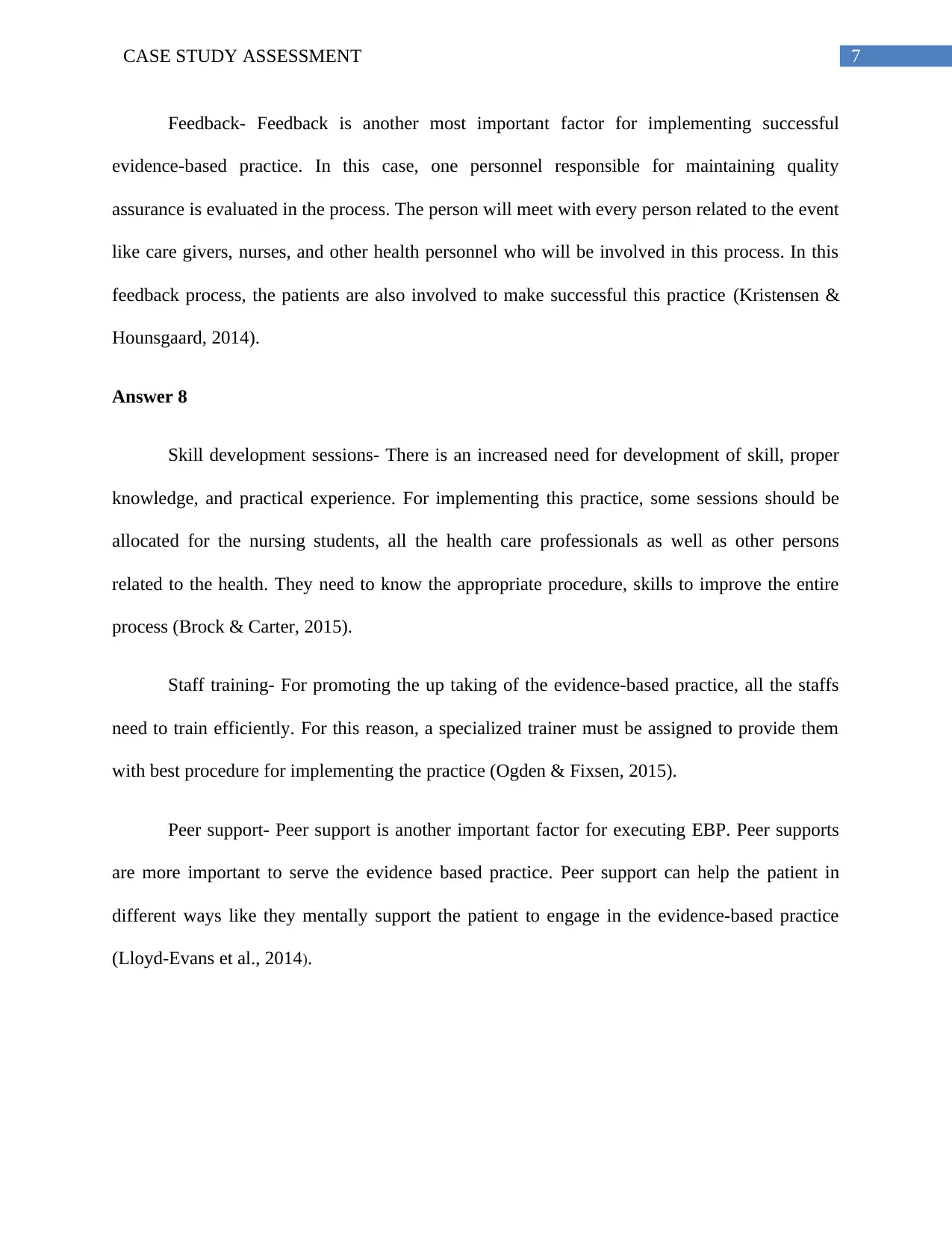
7CASE STUDY ASSESSMENT
Feedback- Feedback is another most important factor for implementing successful
evidence-based practice. In this case, one personnel responsible for maintaining quality
assurance is evaluated in the process. The person will meet with every person related to the event
like care givers, nurses, and other health personnel who will be involved in this process. In this
feedback process, the patients are also involved to make successful this practice (Kristensen &
Hounsgaard, 2014).
Answer 8
Skill development sessions- There is an increased need for development of skill, proper
knowledge, and practical experience. For implementing this practice, some sessions should be
allocated for the nursing students, all the health care professionals as well as other persons
related to the health. They need to know the appropriate procedure, skills to improve the entire
process (Brock & Carter, 2015).
Staff training- For promoting the up taking of the evidence-based practice, all the staffs
need to train efficiently. For this reason, a specialized trainer must be assigned to provide them
with best procedure for implementing the practice (Ogden & Fixsen, 2015).
Peer support- Peer support is another important factor for executing EBP. Peer supports
are more important to serve the evidence based practice. Peer support can help the patient in
different ways like they mentally support the patient to engage in the evidence-based practice
(Lloyd-Evans et al., 2014).
Feedback- Feedback is another most important factor for implementing successful
evidence-based practice. In this case, one personnel responsible for maintaining quality
assurance is evaluated in the process. The person will meet with every person related to the event
like care givers, nurses, and other health personnel who will be involved in this process. In this
feedback process, the patients are also involved to make successful this practice (Kristensen &
Hounsgaard, 2014).
Answer 8
Skill development sessions- There is an increased need for development of skill, proper
knowledge, and practical experience. For implementing this practice, some sessions should be
allocated for the nursing students, all the health care professionals as well as other persons
related to the health. They need to know the appropriate procedure, skills to improve the entire
process (Brock & Carter, 2015).
Staff training- For promoting the up taking of the evidence-based practice, all the staffs
need to train efficiently. For this reason, a specialized trainer must be assigned to provide them
with best procedure for implementing the practice (Ogden & Fixsen, 2015).
Peer support- Peer support is another important factor for executing EBP. Peer supports
are more important to serve the evidence based practice. Peer support can help the patient in
different ways like they mentally support the patient to engage in the evidence-based practice
(Lloyd-Evans et al., 2014).
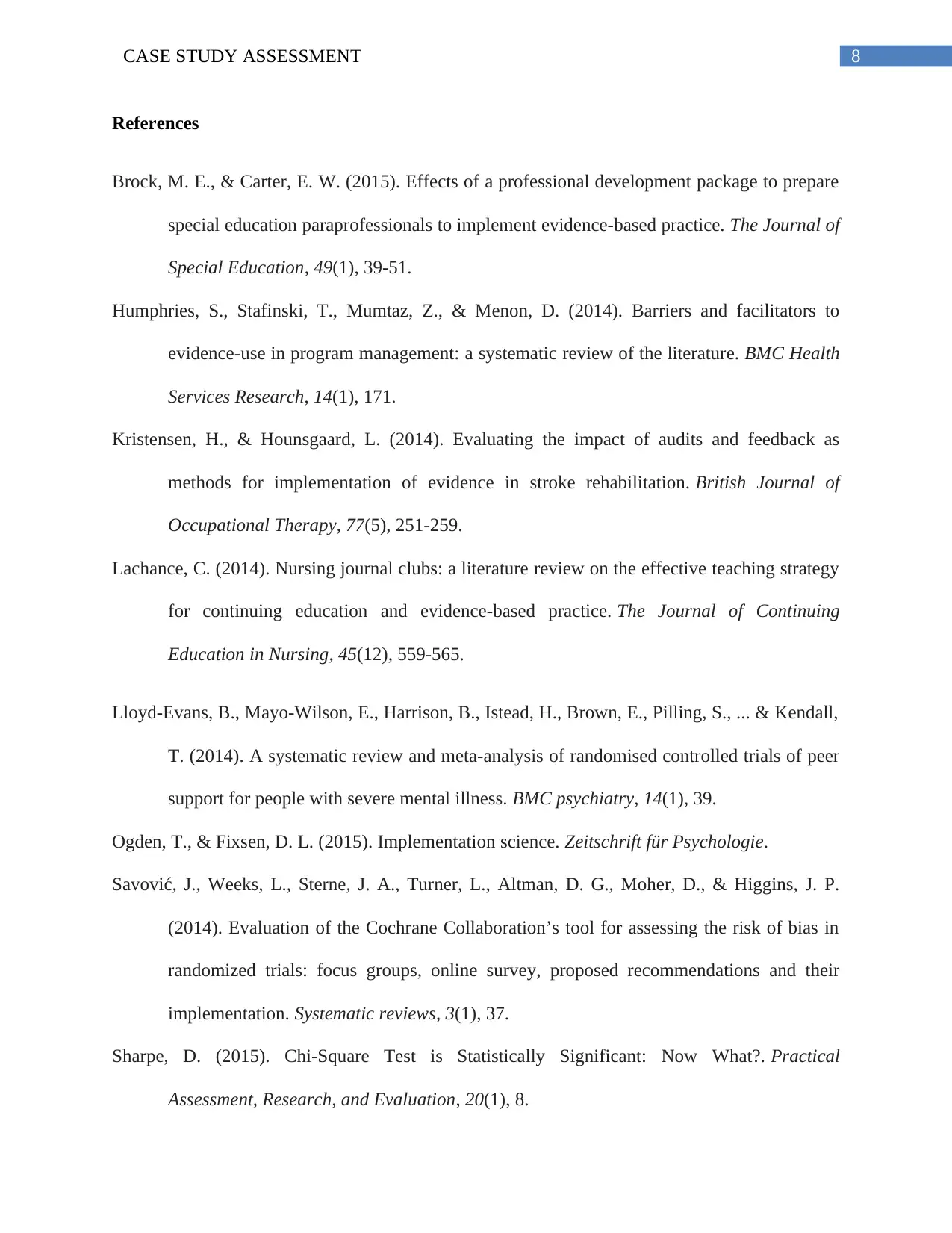
8CASE STUDY ASSESSMENT
References
Brock, M. E., & Carter, E. W. (2015). Effects of a professional development package to prepare
special education paraprofessionals to implement evidence-based practice. The Journal of
Special Education, 49(1), 39-51.
Humphries, S., Stafinski, T., Mumtaz, Z., & Menon, D. (2014). Barriers and facilitators to
evidence-use in program management: a systematic review of the literature. BMC Health
Services Research, 14(1), 171.
Kristensen, H., & Hounsgaard, L. (2014). Evaluating the impact of audits and feedback as
methods for implementation of evidence in stroke rehabilitation. British Journal of
Occupational Therapy, 77(5), 251-259.
Lachance, C. (2014). Nursing journal clubs: a literature review on the effective teaching strategy
for continuing education and evidence-based practice. The Journal of Continuing
Education in Nursing, 45(12), 559-565.
Lloyd-Evans, B., Mayo-Wilson, E., Harrison, B., Istead, H., Brown, E., Pilling, S., ... & Kendall,
T. (2014). A systematic review and meta-analysis of randomised controlled trials of peer
support for people with severe mental illness. BMC psychiatry, 14(1), 39.
Ogden, T., & Fixsen, D. L. (2015). Implementation science. Zeitschrift für Psychologie.
Savović, J., Weeks, L., Sterne, J. A., Turner, L., Altman, D. G., Moher, D., & Higgins, J. P.
(2014). Evaluation of the Cochrane Collaboration’s tool for assessing the risk of bias in
randomized trials: focus groups, online survey, proposed recommendations and their
implementation. Systematic reviews, 3(1), 37.
Sharpe, D. (2015). Chi-Square Test is Statistically Significant: Now What?. Practical
Assessment, Research, and Evaluation, 20(1), 8.
References
Brock, M. E., & Carter, E. W. (2015). Effects of a professional development package to prepare
special education paraprofessionals to implement evidence-based practice. The Journal of
Special Education, 49(1), 39-51.
Humphries, S., Stafinski, T., Mumtaz, Z., & Menon, D. (2014). Barriers and facilitators to
evidence-use in program management: a systematic review of the literature. BMC Health
Services Research, 14(1), 171.
Kristensen, H., & Hounsgaard, L. (2014). Evaluating the impact of audits and feedback as
methods for implementation of evidence in stroke rehabilitation. British Journal of
Occupational Therapy, 77(5), 251-259.
Lachance, C. (2014). Nursing journal clubs: a literature review on the effective teaching strategy
for continuing education and evidence-based practice. The Journal of Continuing
Education in Nursing, 45(12), 559-565.
Lloyd-Evans, B., Mayo-Wilson, E., Harrison, B., Istead, H., Brown, E., Pilling, S., ... & Kendall,
T. (2014). A systematic review and meta-analysis of randomised controlled trials of peer
support for people with severe mental illness. BMC psychiatry, 14(1), 39.
Ogden, T., & Fixsen, D. L. (2015). Implementation science. Zeitschrift für Psychologie.
Savović, J., Weeks, L., Sterne, J. A., Turner, L., Altman, D. G., Moher, D., & Higgins, J. P.
(2014). Evaluation of the Cochrane Collaboration’s tool for assessing the risk of bias in
randomized trials: focus groups, online survey, proposed recommendations and their
implementation. Systematic reviews, 3(1), 37.
Sharpe, D. (2015). Chi-Square Test is Statistically Significant: Now What?. Practical
Assessment, Research, and Evaluation, 20(1), 8.
⊘ This is a preview!⊘
Do you want full access?
Subscribe today to unlock all pages.

Trusted by 1+ million students worldwide
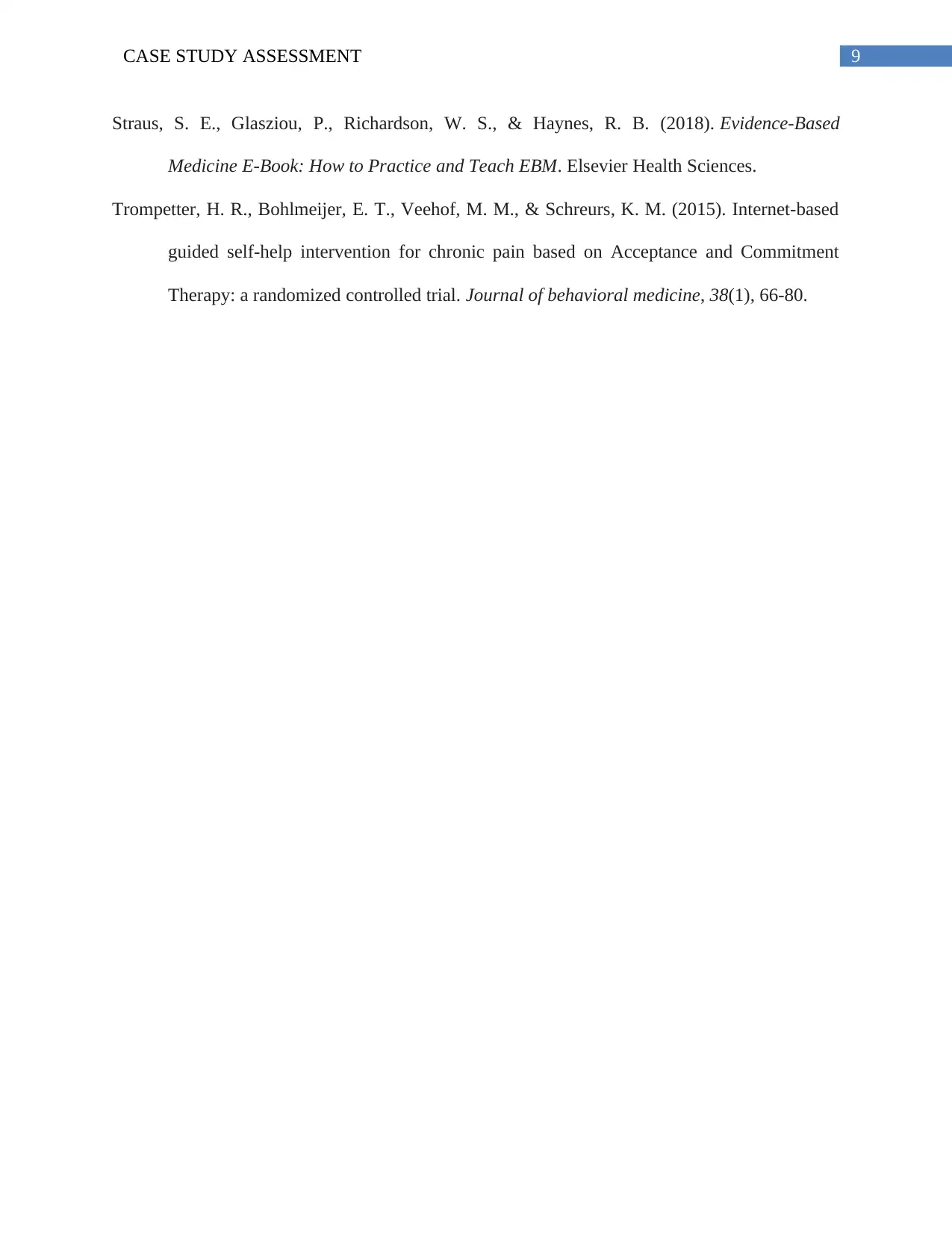
9CASE STUDY ASSESSMENT
Straus, S. E., Glasziou, P., Richardson, W. S., & Haynes, R. B. (2018). Evidence-Based
Medicine E-Book: How to Practice and Teach EBM. Elsevier Health Sciences.
Trompetter, H. R., Bohlmeijer, E. T., Veehof, M. M., & Schreurs, K. M. (2015). Internet-based
guided self-help intervention for chronic pain based on Acceptance and Commitment
Therapy: a randomized controlled trial. Journal of behavioral medicine, 38(1), 66-80.
Straus, S. E., Glasziou, P., Richardson, W. S., & Haynes, R. B. (2018). Evidence-Based
Medicine E-Book: How to Practice and Teach EBM. Elsevier Health Sciences.
Trompetter, H. R., Bohlmeijer, E. T., Veehof, M. M., & Schreurs, K. M. (2015). Internet-based
guided self-help intervention for chronic pain based on Acceptance and Commitment
Therapy: a randomized controlled trial. Journal of behavioral medicine, 38(1), 66-80.
Paraphrase This Document
Need a fresh take? Get an instant paraphrase of this document with our AI Paraphraser

10CASE STUDY ASSESSMENT
Appendices
Questions Yes Can’t tell No
1. Did the review
address a clearly
focused question?
✔
2. Did the authors
look for the right type
of papers?
✔
3. Do you think all the
important, relevant
studies were
included?
✔
4. Did the review’s
authors do enough to
assess quality of the
included studies?
✔
5. If the results of the
review have been
combined, was it
reasonable to do so?
✔
6. What are the
overall results of the
✔
Appendices
Questions Yes Can’t tell No
1. Did the review
address a clearly
focused question?
✔
2. Did the authors
look for the right type
of papers?
✔
3. Do you think all the
important, relevant
studies were
included?
✔
4. Did the review’s
authors do enough to
assess quality of the
included studies?
✔
5. If the results of the
review have been
combined, was it
reasonable to do so?
✔
6. What are the
overall results of the
✔
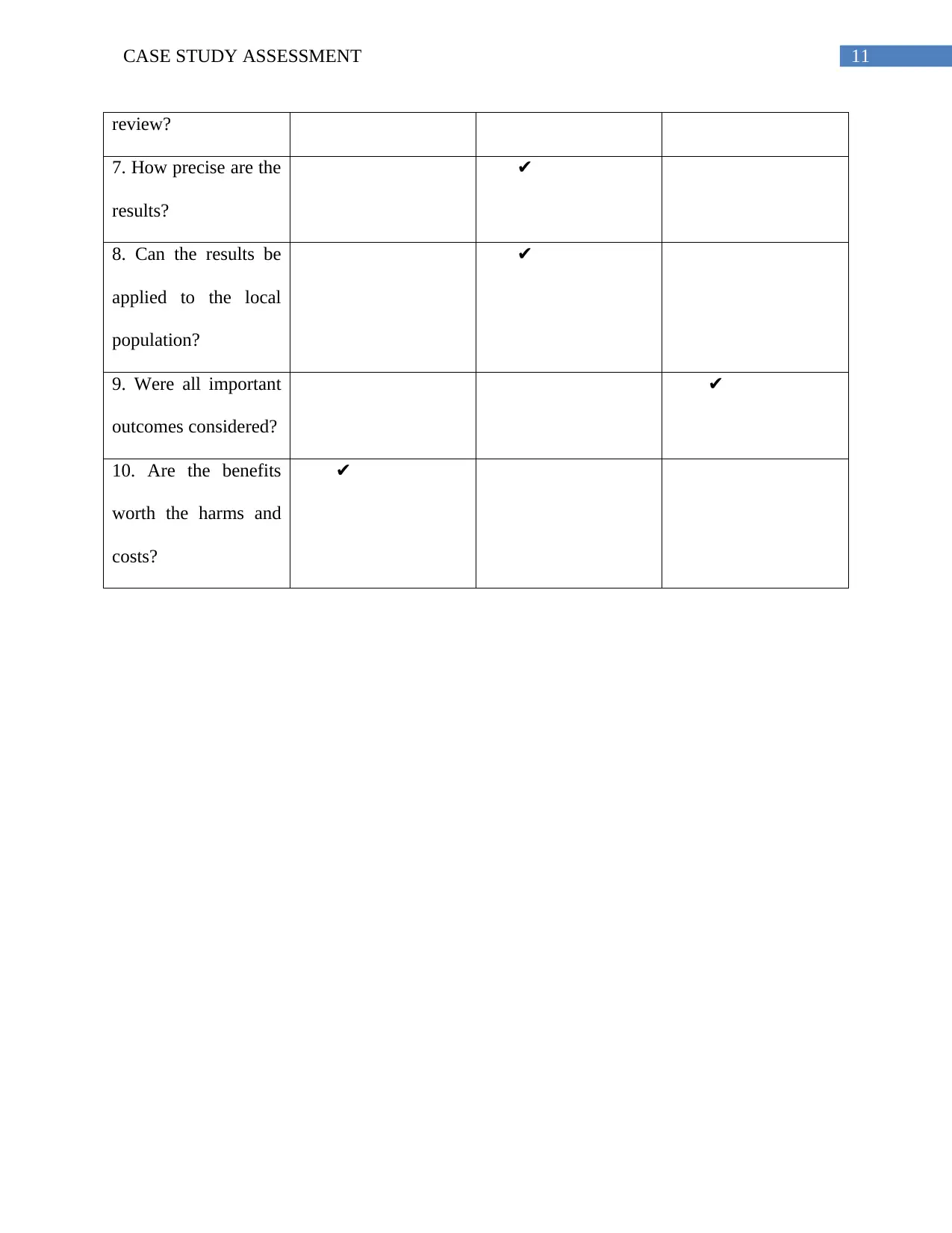
11CASE STUDY ASSESSMENT
review?
7. How precise are the
results?
✔
8. Can the results be
applied to the local
population?
✔
9. Were all important
outcomes considered?
✔
10. Are the benefits
worth the harms and
costs?
✔
review?
7. How precise are the
results?
✔
8. Can the results be
applied to the local
population?
✔
9. Were all important
outcomes considered?
✔
10. Are the benefits
worth the harms and
costs?
✔
⊘ This is a preview!⊘
Do you want full access?
Subscribe today to unlock all pages.

Trusted by 1+ million students worldwide
1 out of 12
Related Documents
Your All-in-One AI-Powered Toolkit for Academic Success.
+13062052269
info@desklib.com
Available 24*7 on WhatsApp / Email
![[object Object]](/_next/static/media/star-bottom.7253800d.svg)
Unlock your academic potential
Copyright © 2020–2025 A2Z Services. All Rights Reserved. Developed and managed by ZUCOL.





